Low-Work Russell Groundcovers: Beat Clay Soil Challenges
Quick Summary
- Clay soil in Russell/Ottawa presents challenges like poor drainage and compaction.
- Low-work groundcovers are excellent alternatives to turfgrass for these conditions.
- Groundcovers suppress weeds, reduce erosion, require less maintenance, and add beauty.
- Top choices for local clay include Ajuga, Sedum, Vinca Minor, Lamium, and Native Wild Strawberry.
- Proper soil preparation (amending widely with compost) is crucial for success.
Let's face it, Russell homeowners, is your lawn sometimes more of a *mud*sterpiece than a masterpiece? Trying to wrestle lush green grass out of that stubborn clay soil can feel like a full-time job you didn't sign up for. You mow, you water, you plead... and still, you might end up with patchy spots that seem to mock your efforts. Sound familiar?
Well, put down that heavy rake and take heart! There's a smarter, easier way to achieve beautiful greenery. Across Ottawa and right here in lovely Russell, savvy gardeners are turning to a fantastic landscaping solution: low-work groundcovers. Think of them as nature's carpet – attractive, hardy plants that spread to cover the soil, suppressing weeds and looking great with *way* less fuss than traditional turf.
Ready to ditch the lawn stress? Let us help!
Request Your Free Quote Today!Forget the endless cycle of lawn maintenance frustration. These ground-hugging heroes can handle tricky spots, reduce erosion, and add texture and colour to your yard. In this guide, we'll dig into some top groundcover choices perfect for our local climate, explore their amazing benefits, and share practical tips to help you transform your challenging patches into a thriving, beautiful, and *easy-care* landscape. Ready to trade lawn stress for garden success? Let's get growing!
The Clay Conundrum: Why Ottawa Soil Can Be a Gardener's Frenemy
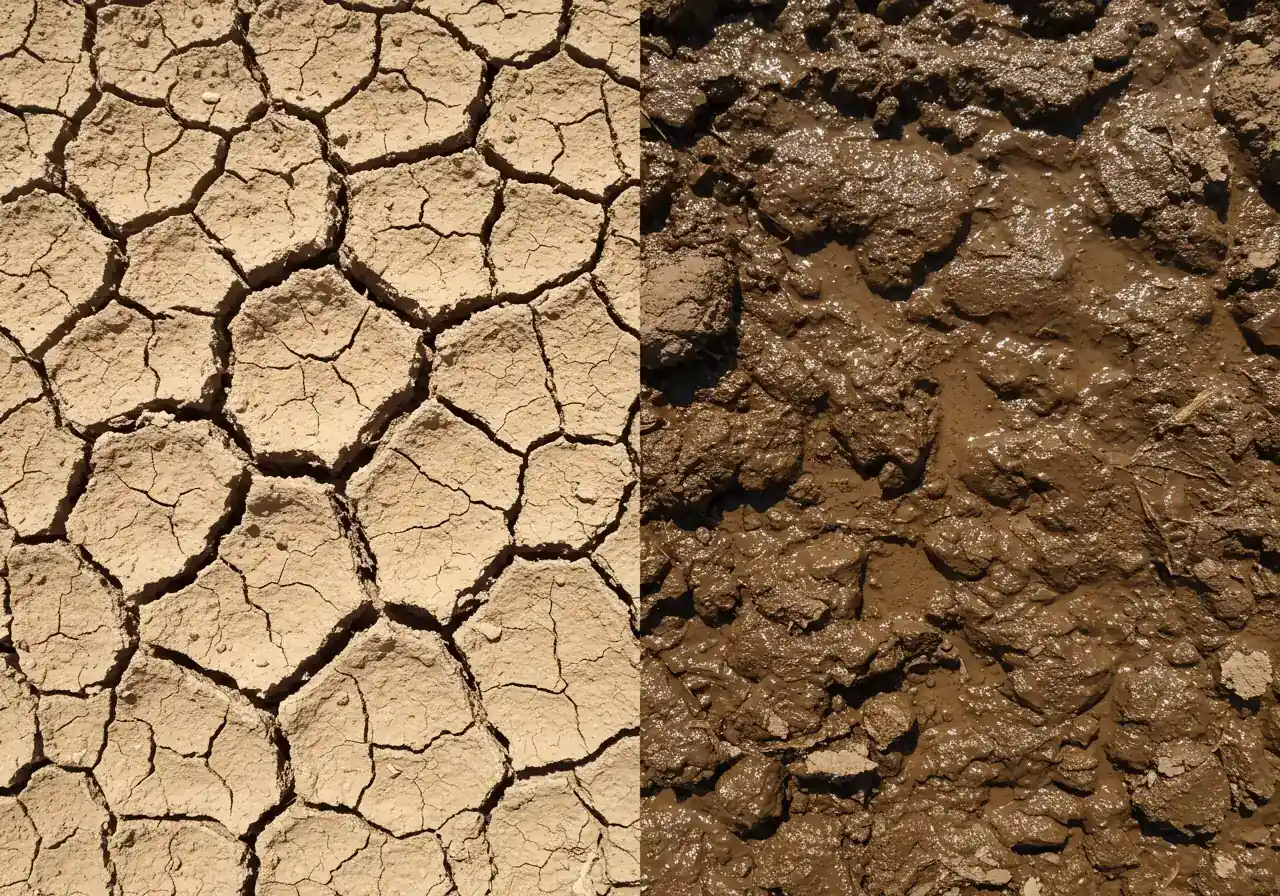
Ah, Ottawa soil. If your garden sometimes feels less like a fluffy paradise and more like a pottery class waiting to happen, you've likely met our region's star player: clay. It's the ultimate gardening "frenemy" – it has its perks, but oh boy, can it throw some curveballs, especially for homeowners in areas like Barrhaven or Greely known for their heavy clay base.
So, what’s the dirt on clay? Think of it like stacks of tiny, microscopic plates. When these plates get wet, they cling together tightly, holding onto water like a toddler holds onto a favourite toy. This means *poor drainage*. After a heavy spring melt or a summer downpour, water can just sit there, potentially drowning plant roots and creating soggy, muddy patches. Dealing with this waterlogging is often a top priority, sometimes needing specific solutions like implementing Embrun spring drainage fixes to prevent flooding. Poor drainage isn't just a plant problem; it can affect your entire property, highlighting why understanding solutions like how Richmond spring grading saves homes from water issues is so important for landscaping success.
Then, there's the flip side. When that clay dries out? It can compact into something resembling concrete. Roots struggle to push through, and water has a hard time penetrating the surface next time it rains. Our lovely Ottawa freeze-thaw cycles? They make this compaction even worse over time, squeezing the life (and air!) right out of the soil. Plants can get seriously stressed trying to survive these extremes. Keeping them healthy often means thinking ahead, perhaps with a Winchester fall plant health plan saves money strategy focused on resilience. Even garden features aren't immune; poor drainage impacts water levels and quality, making tasks like Russell pond prep winter freeze damage crucial for pond owners dealing with clay soils.
Now, for the "friend" part of frenemy: clay soil is actually packed with nutrients! The challenge is that compaction and poor drainage can make it hard for plants to *access* those goodies. Proper soil preparation techniques are vital.
This is exactly why traditional turf grass often struggles, and why low-maintenance groundcovers are such fantastic alternatives. They tend to be tougher and more adaptable to these challenging conditions. While amending clay soil with plenty of organic matter (like compost) is always recommended to improve structure and drainage over time, choosing plants suited to the reality of your soil is key. If wrestling with clay feels like too much, remember there are expert landscaping and gardening services available to help diagnose issues and create beautiful, thriving outdoor spaces despite the clay conundrum.
Groundcover Superpowers: More Than Just Pretty Fillers!
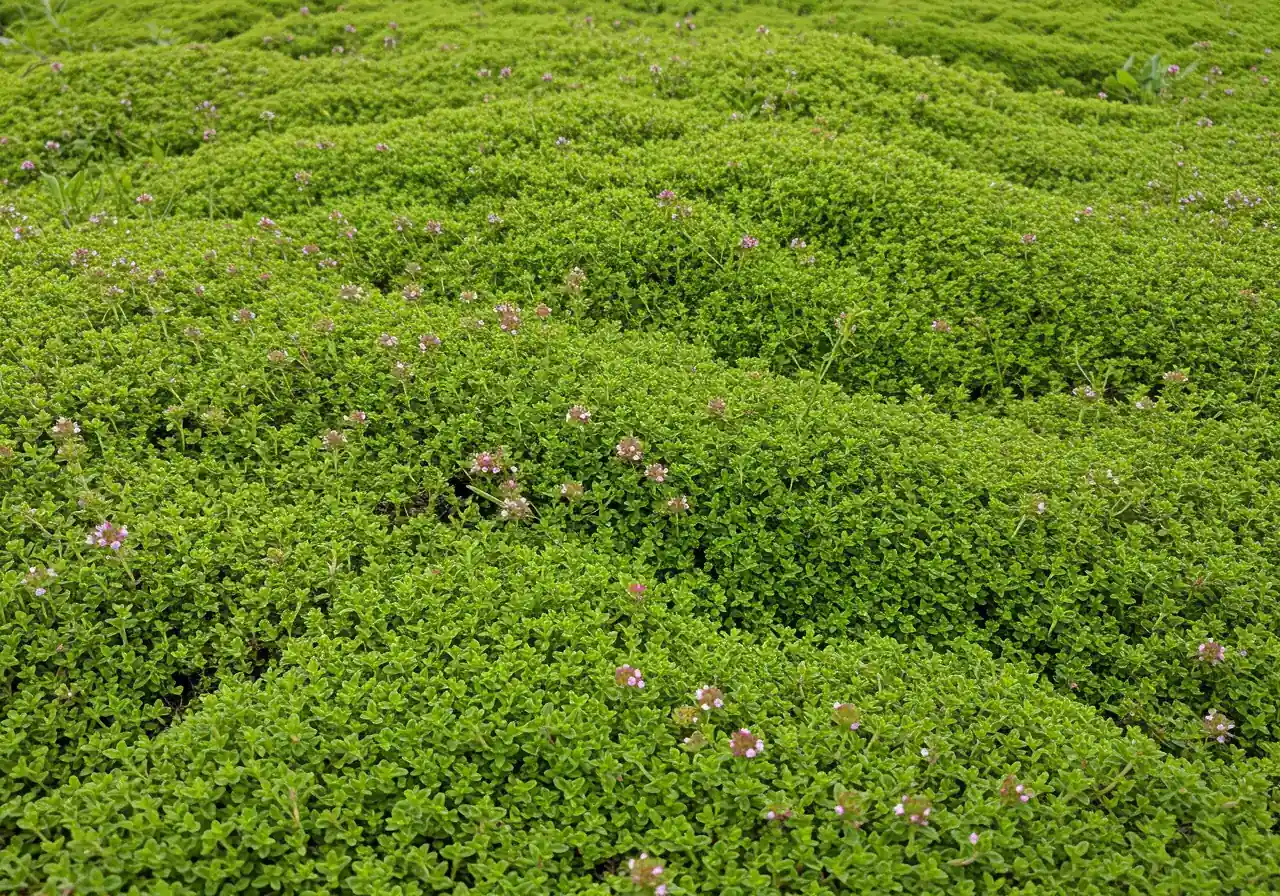
Alright, let's talk about groundcovers! Often overlooked, these low-growing plants are like the superheroes of the gardening world, especially here in Ottawa where our clay soil can be a bit, well, *challenging*. Forget thinking of them as just space fillers – they pack some serious landscaping punch. Let’s uncover their amazing superpowers:
- The Weed Warrior: Tired of waging war on weeds every weekend? Groundcovers are your secret weapon! As they spread, they form a dense living carpet that blocks sunlight and physically crowds out unwanted invaders. Less weeding means more time relaxing in your garden. Imagine reclaiming your weekends instead of constantly needing a Vernon yard cleanup service just to battle dandelions in that tricky back corner!
- The Soil Saver Brigade: Got slopes? Worried about erosion after heavy rain? Groundcover roots act like a natural net, holding soil particles together. This is *super* helpful on banks or bare patches, preventing precious topsoil (even stubborn clay!) from washing away. Plus, they act like a living mulch, shading the soil, keeping it cooler in summer, and reducing water evaporation. Smart *and* resourceful! Consider learning more about our commitment to sustainable practices.
- The Low-Maintenance Marvel: This might be their most famous superpower. Once established, many groundcovers require significantly less mowing, watering, and fertilizing compared to traditional grass lawns. Think of the time and effort saved! While getting them started takes some initial care (sometimes beginning with a thorough Ottawa garden clean up service to prepare the bed), the long-term payoff in reduced work is fantastic. Of course, if you need a hand with planting or occasional tidying, professional landscaping and gardening services are available to help keep things looking sharp.
- The Eco-Enhancer: Want to give back to nature? Planting groundcovers, especially native varieties, is a brilliant way to do it. Many offer nectar and pollen for bees, butterflies, and other beneficial insects, boosting local biodiversity right in your yard. They create mini-habitats, making your garden a friendlier place for our little ecosystem buddies. Even these hardy plants appreciate some TLC to thrive, which an ongoing city garden maintenance service can help with, ensuring they stay healthy for pollinators. Find local resources via the Ottawa Horticultural Society.
- The Beauty Booster: Let’s not forget – groundcovers look great! They add wonderful texture, colour, and form to your landscape design. Think beyond basic green turf. Imagine colourful Sedum varieties filling a rock garden, fragrant Creeping Thyme softening pathway edges, or the lush foliage of Vinca Minor creating an elegant carpet under trees in a lovely Manotick neighbourhood. They bring year-round visual interest that plain grass just can't match. Check out some inspiring transformations!
So, ditch the demanding turf in those difficult spots and embrace these ground-hugging heroes! They work *with* your landscape, solve problems, and look fantastic doing it. Your garden will practically say thank you for making the switch to these hardworking, beautiful plants. Visit our Google My Business page for more reviews and info: Clean Yards on Google.
Top 5 Low-Work Groundcover Picks for Russell's Clay Soil
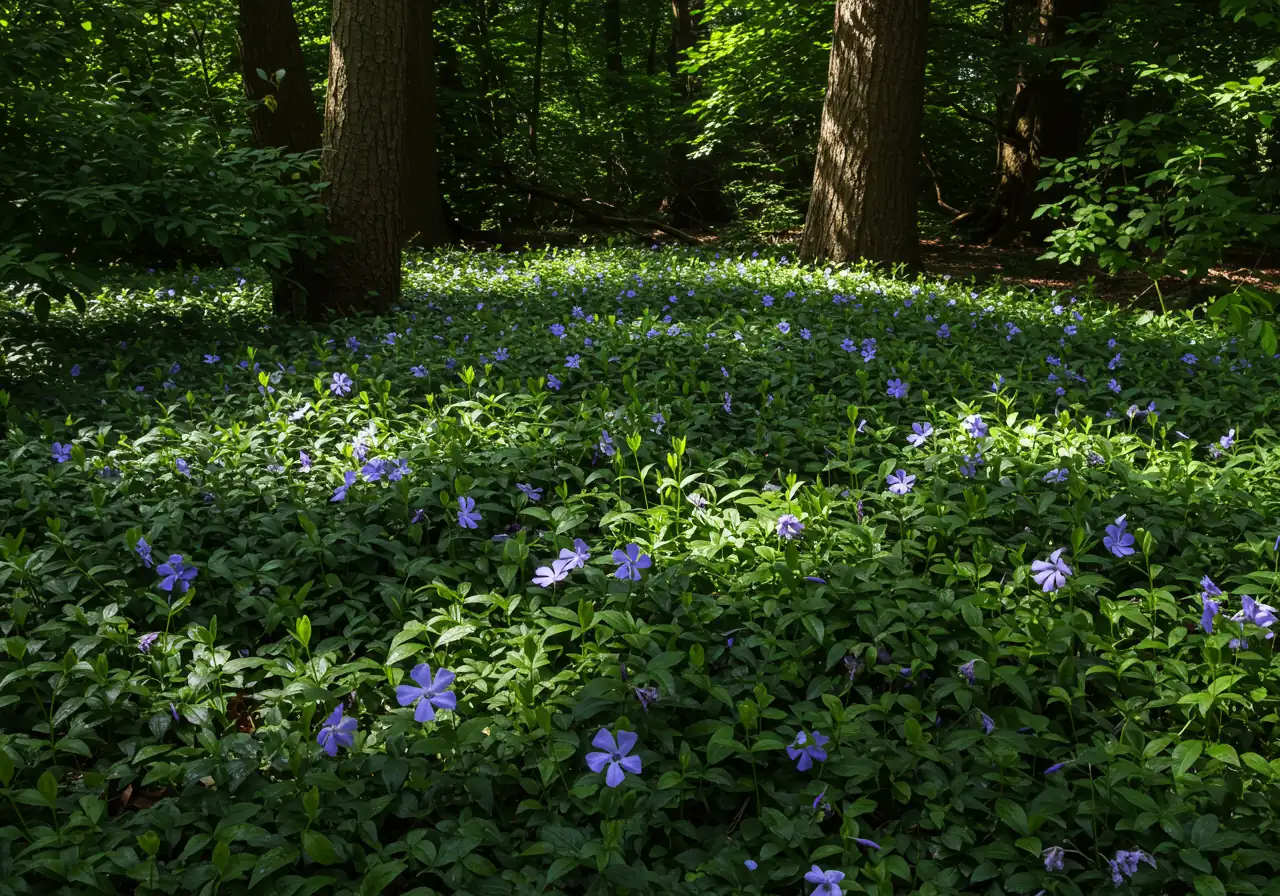
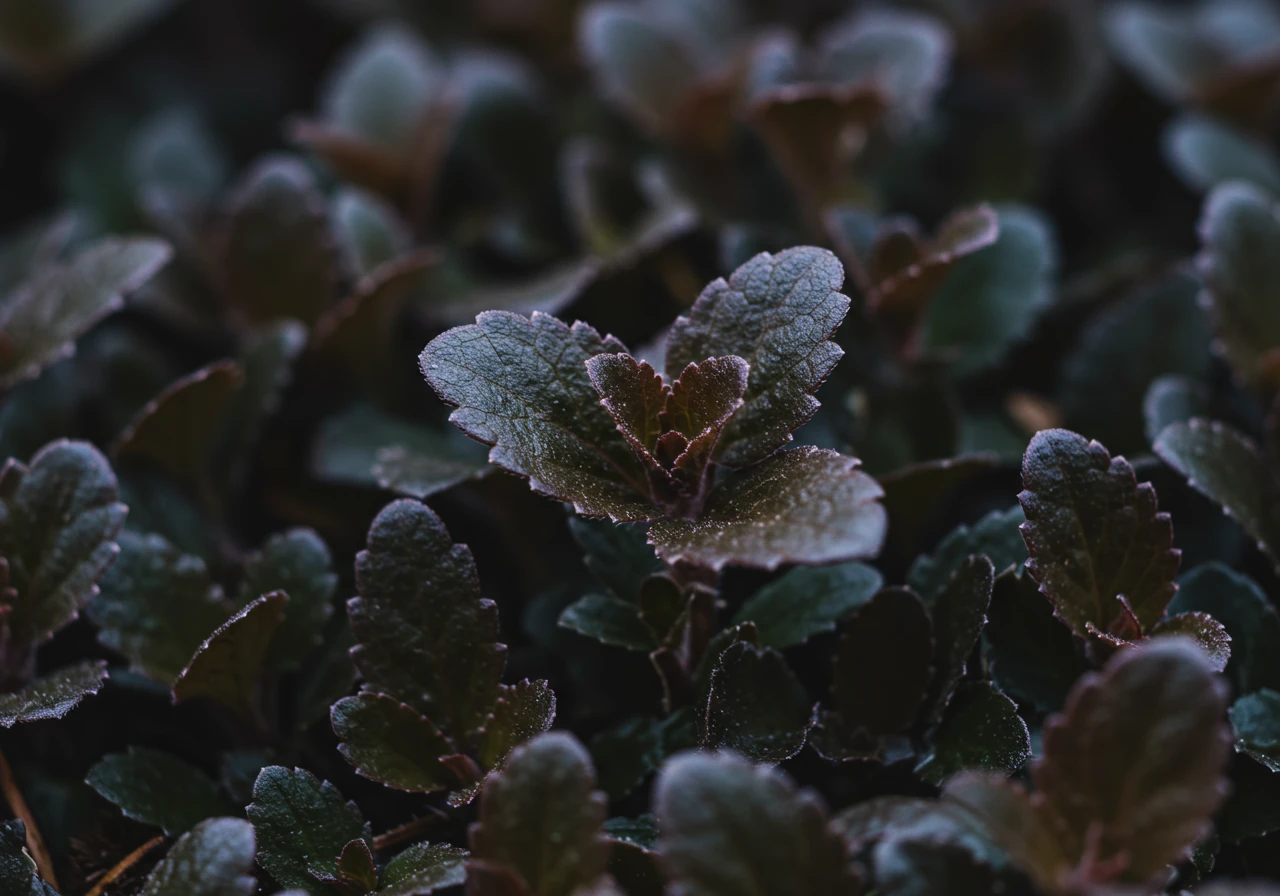
Alright, fellow Russell and Ottawa-area gardeners, let's get down to the good stuff: choosing plants that won't just *survive* our notorious clay soil, but actually *thrive* with minimal fuss. Wrestling with turf is out; easy-care beauty is in! Here are five fantastic groundcover options that are tough enough for our Zone 5a climate and tolerant of clay conditions. Remember, even clay-tolerant plants benefit from adding compost to improve soil structure over time!
-
Ajuga reptans (Bugleweed)
- Description: This is a real trooper! Ajuga forms a dense, low mat of attractive foliage, often glossy and ranging from green to deep bronze or purple depending on the variety. In spring, it sends up charming spikes of blue, purple, or pink flowers that bees adore. It spreads via runners (stolons), filling in areas relatively quickly.
- Care Needs: Happy in anything from full sun to partial shade. More sun often means better foliage colour, but it tolerates shade well, making it versatile for spots under trees perhaps found in established Manotick yards. Average water needs; moderately drought-tolerant once established.
- Clay Tolerance: Good. It handles heavy soil better than many plants, though like most, it doesn't love being constantly waterlogged.
- Benefits: Excellent weed suppressor due to its dense growth. Fast coverage. Pretty spring flowers. Deer resistant! Ideal for low-maintenance garden designs.
-
Sedum spurium (Creeping Stonecrop - 'Dragon's Blood' or similar)
- Description: Looking for something tough-as-nails for a hot, sunny spot? Creeping Sedums are your answer! These succulents have fleshy leaves (often reddish-bronze in 'Dragon's Blood') and clusters of star-shaped flowers (usually pink or red) in late summer. They are super low-growing.
- Care Needs: Full sun is best for vibrant colour and flowers. Excellent drought tolerance once established – do not overwater! Perfect for those drier parts of a Nepean or Osgoode garden that bake in the summer sun.
- Clay Tolerance: Surprisingly tolerant of clay *as long as drainage is decent*. Avoid planting in low spots where water pools. Improves with grit or sand added to the planting hole in heavy clay. Check our material selection guide for soil amendment ideas.
- Benefits: Extremely low water needs. Great for rock gardens, slopes, or path edges. Adds interesting texture and colour. Attracts pollinators.
-
Vinca Minor (Periwinkle / Creeping Myrtle)
- Description: An old-fashioned favourite for a reason. Vinca Minor creates a lovely, evergreen carpet of glossy dark green leaves. It produces charming periwinkle-blue (or sometimes white or purple) flowers sporadically from spring to fall. It spreads reliably via trailing stems that root where they touch the ground.
- Care Needs: Thrives in partial shade to full shade, making it ideal for planting under trees or on the north side of buildings. Tolerates sun if moisture is consistent. Average water needs.
- Clay Tolerance: Quite tolerant of heavy clay soil.
- Benefits: Evergreen colour year-round. Excellent for shade where grass struggles. Very low maintenance once established. Caution: Can be quite vigorous and may need edging to keep it contained; good mulching and edging practices help define its space.
-
Lamium maculatum (Spotted Dead Nettle)
- Description: Don't let the name fool you; this plant is beautiful! Lamium brightens shady spots with its attractive foliage, often variegated with silver or white markings, and clusters of small, snapdragon-like flowers in pink, purple, or white appearing in spring and sometimes again later. Different varieties offer different looks.
- Care Needs: Prefers partial to full shade. Average water requirements; dislikes drying out completely but also hates wet feet (typical clay issue!). Benefits from well-draining soil amendment in heavy clay.
- Clay Tolerance: Moderate. It will grow in clay but performs best if the soil is improved with organic matter.
- Benefits: Brightens up shady corners. Lovely foliage and flowers. Generally low maintenance and deer resistant. Less aggressive spreader than Vinca. Perfect for brightening areas needing a Metcalf garden clean up service.
-
Fragaria virginiana (Wild Strawberry - *Native Ontario Plant*)
- Description: Let's bring in a local hero! This native groundcover forms patches of familiar three-lobed strawberry leaves. It produces small white flowers in spring followed by tiny, edible (and tasty!) wild strawberries in early summer. Spreads readily via runners. Perfect for naturalizing an area. More native plant info can be found via Rideau Valley Conservation Authority resources.
- Care Needs: Adaptable! Grows in full sun to partial shade. Prefers moist, well-drained soil but is quite tolerant of various conditions, including clay.
- Clay Tolerance: Good tolerance for clay soils, common in areas around Russell and Metcalfe.
- Benefits: Native plant supporting local ecosystems. Edible fruit (bonus!). Adaptable and relatively easy to grow. Good seasonal interest. A great choice if you're aiming for a more natural landscape aesthetic. Preparing the bed might involve clearing existing weeds – if it's a large area, consider a Marionville garden clean up service to get a head start.
| Groundcover | Sun Needs | Water Needs | Clay Tolerance | Key Benefit |
|---|---|---|---|---|
| Ajuga reptans | Sun to Part Shade | Average | Good | Fast weed suppression |
| Sedum spurium | Full Sun | Low (Drought Tolerant) | Good (needs drainage) | Very low water use |
| Vinca Minor | Part Shade to Full Shade | Average | Good | Excellent for shade |
| Lamium maculatum | Part Shade to Full Shade | Average | Moderate | Brightens shade, variegated leaves |
| Fragaria virginiana | Sun to Part Shade | Adaptable | Good | Native, edible fruit |
Making Your Choice
Consider your specific spot: how much sun does it get? Is it typically wet or dry? Choosing the right plant for the right place is key. Preparing the planting area well, perhaps starting with a thorough fall or spring property clean up, gives your new groundcovers the best chance to establish quickly. You might find creating a simple comparison table (like the one above!) helps visualize the best fit. Keep an eye on enthusiastic spreaders; sometimes help from a city property cleanup service is handy for maintaining tidy edges down the line. Plant these clay-busters, give them a little care to get started, and your future self will definitely thank you for choosing such low-work beauties!
Planting Power: Getting Your Groundcovers Grounded in Clay
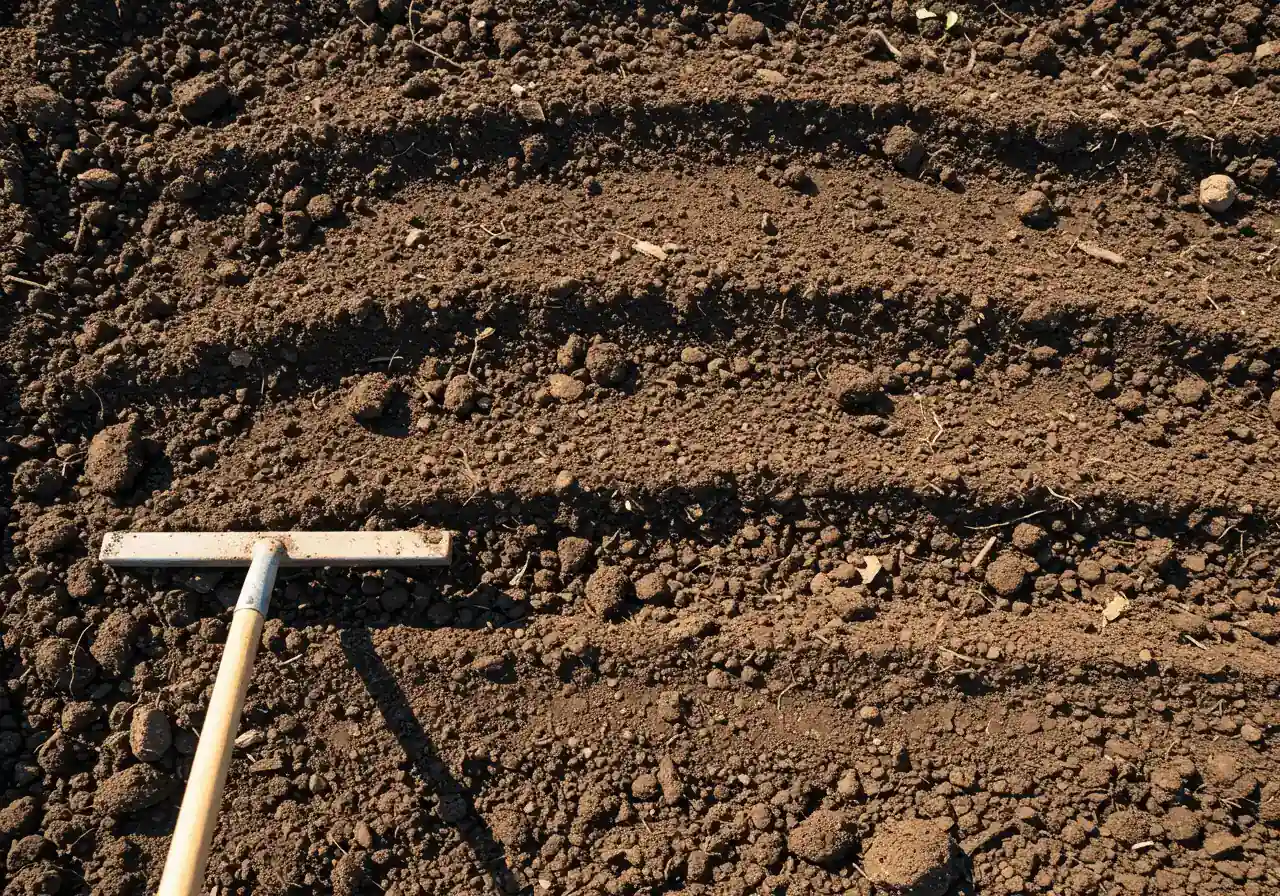
Alright, you've picked your perfect groundcover troopers, ready to tackle that tricky clay spot. Now comes the slightly mucky part – getting them planted correctly! Don't sweat it; planting in Ottawa's clay soil isn't mission impossible. It just requires a little extra TLC and know-how. Think of it as giving your new plants a VIP welcome to their new home. Here’s how to get those groundcovers grounded:
Step 1: Prepare the Whole Neighbourhood (Not Just the House!)
This is *the* most crucial step for clay soil success. Simply digging a small hole and popping the plant in creates what gardeners grimly call the "bathtub effect." Water hits the dense surrounding clay, fills up your nicely loosened hole, and drowns the poor plant's roots. Yikes!
- Action: Instead, amend a *wide area* where your groundcovers will spread. Remove existing weeds or unwanted grass first. For larger patches, a professional clearing might be easiest; consider looking into a thorough Marionville property cleanup service to get a blank slate. Then, spread 3-4 inches of *good quality compost* or well-rotted manure over the entire planting zone. Gently work this organic matter into the top 6-8 inches of your existing clay soil using a garden fork or tiller. This improves drainage and aeration *around* the plants, not just beneath them. This principle of broad soil improvement is essential for many landscaping projects, including achieving successful Ottawa sod installation – healthy soil is key everywhere! Proper soil preparation is non-negotiable.
Step 2: Dig Smart Holes
Now that your soil is prepped, digging the actual holes is much easier.
- Action: Dig holes only as deep as the plant's root ball and about twice as wide. Rough up the sides of the hole slightly if they look smooth or glazed (a common issue in clay) to help roots penetrate outwards. Check the plant tag for recommended spacing – give them room to spread!
Step 3: The Gentle Tuck-In
Handle your new plants with care!
- Action: Gently loosen any circling roots on the plant's root ball. Place the plant in the hole so the top of its root ball is *level with* the surrounding soil surface. Planting too deep is a common mistake in clay and can lead to rot. Backfill the hole with the amended soil you dug out, lightly firming it around the roots to remove major air pockets. Don't pack it down hard! Need help with a larger planting project? Check our garden install services.
Step 4: Mulch is Your Friend
Mulching is especially beneficial over clay soil.
- Action: Apply a 2-3 inch layer of organic mulch (like shredded bark, wood chips, or straw) around the plants, but keep it an inch or two away from the plant stems themselves to prevent moisture buildup right against the plant. Mulch helps retain soil moisture (so the clay doesn't bake hard), suppresses weeds, and regulates soil temperature. Sometimes, managing large mulched areas or edges over time requires assistance; a reliable city property cleanup service can help keep things tidy. Learn about mulching and edging benefits here.
Step 5: Water Wisely, Especially at First
New plants need consistent moisture to establish roots, but clay holds water tenaciously.
- Action: Water your newly planted groundcovers deeply right after planting. Then, monitor the soil moisture carefully for the first few weeks. Stick your finger down an inch or two into the soil near the plants. If it feels dry, water deeply again. If it feels moist, *wait*. Overwatering is a big risk in clay, especially in areas known for drainage challenges, like parts of Barrhaven. Allow the soil surface to dry slightly between waterings once plants are established. Consistent care after planting ensures success; if you need help with ongoing garden upkeep, a regular city garden clean up service can manage watering, weeding, and more. And remember, if engaging any professional service, it's always smart to review their terms and conditions first. Also, check our privacy policy regarding data handling.
Follow these steps, and your groundcovers will be well on their way to creating that beautiful, low-maintenance carpet you’re dreaming of, even in challenging Ottawa clay! You've got this!
Groundcover Spreading Habits
Understanding how quickly groundcovers spread helps in planning:
- Fast Spreaders: Ajuga, Vinca Minor can cover ground relatively quickly, useful for large areas but may need edging.
- Moderate Spreaders: Lamium, Wild Strawberry fill in nicely without being overly aggressive.
- Slow/Clump Spreaders: Some Sedum varieties spread more slowly, ideal for contained spaces like rock gardens.
Shade Tolerance Comparison
Matching groundcover to light conditions is key:
- Full Shade Champions: Vinca Minor, Lamium are top choices for areas with little direct sun.
- Partial Shade Adaptable: Ajuga, Wild Strawberry perform well with some shade, often tolerating full shade too.
- Sun Lovers: Sedum varieties generally require full sun for best performance and flowering.
Drought Tolerance Levels
Consider water availability, especially in sunny, dry spots:
- Very Drought Tolerant: Sedum spurium excels in dry conditions once established.
- Moderately Drought Tolerant: Ajuga can handle some dryness once roots are established.
- Average Water Needs: Vinca Minor, Lamium, Wild Strawberry prefer consistent moisture but aren't water hogs. Avoid letting them dry out completely for long periods.
Your Ottawa Groundcover Care Calendar: Easy Year-Round TLC
Spring Zing (Late April - May)
Gentle rake, edge patrol, weed check, assess winter damage. Optional light compost feed. Consider a Metcalf yard cleanup service if needed.
Summer Breeze (June - August)
Water only during extended dry spells. Occasional spot weeding. Quick health scan. Book a Metcalf property cleanup service for general tidiness if summer gets busy.
Fall Tidy-Up (September - November)
Gently remove thick leaf layers. Leave a thin layer for insulation. Optional minor trim. Check mulch depth. See our transformations gallery for fall inspiration.
Winter Respite (December - March)
Let snow insulate. Plan next year's projects - maybe a new garden install? Review service terms if applicable.
So, you've got your gorgeous, low-maintenance groundcovers happily established – nice work! While they *are* significantly less demanding than traditional turf, they aren't *quite* zero-maintenance (sorry!). Think of it as minimal effort for maximum reward. Here’s a simple seasonal guide (visualized in the timeline above) to keep your groundcover looking great year-round in our lovely Ottawa climate, without needing a PhD in horticulture.
Estimated Groundcover Coverage After 2 Years (Ideal Conditions)
Note: Coverage estimates are approximate and vary based on specific conditions and variety.
Highlight Box: Quick Wins for Groundcover Glory on Clay!
Quick Wins for Groundcover Glory on Clay!
Clay got you feeling glum? Don't let it cramp your landscaping style! Transforming those tricky patches in Ottawa into thriving groundcover areas is easier than you think. Here are a few shortcuts to success:
- Amend Widely: Remember that "bathtub effect"? Avoid it! Improve the soil in the entire planting area with compost, not just the little hole. Sometimes starting with a clear space helps; consider an initial Ottawa property cleanup service to prep the zone.
- Plant High: Position the top of the plant's root ball *level with* the surrounding soil. Planting too deep is a common oopsie in heavy clay, especially in areas like Winchester known for it.
- Mulch Magic: A 2-3 inch layer of organic mulch is your best friend. It keeps moisture even, suppresses weeds, and makes everything look finished.
- Water Smartly: Give new plants a good drink, then check moisture before watering again. Clay holds water well, so avoid drowning your newbies! Keeping the whole yard maintained helps plants thrive; an Ottawa yard cleanup service can keep things tidy.
- Plan & Prep: Thinking about the scope or cost? Our straightforward estimate and feedback process makes planning easy. If you're in the Metcalfe area, specific help like a Metcalf property cleanup service is available. Ready to get started or have questions? Just contact us!
Your Ottawa Groundcover Questions Answered (FAQ)
You bet! While clay can be tricky, many groundcovers are surprisingly tough customers. The key isn't just the plant, but the *prep*. Amending the soil generously with compost before planting makes a huge difference. Think of it like giving them comfy slippers instead of concrete boots! Choose varieties known to tolerate heavier soils (like some mentioned earlier in this guide), and they'll often perform *better* than struggling turfgrass in those challenging spots.
Honesty hour? It takes *some* elbow grease upfront, but it pays off big time later with reduced maintenance. You don't need to excavate your whole yard! The main job is loosening the top 6-8 inches and mixing in plenty of organic matter (compost is king!) over the *entire* area you plan to plant, not just tiny holes. Proper soil preparation is key for Ottawa gardens and is truly the secret sauce for success in clay. If the thought makes your back ache just reading about it, professional help is always an option!
Shady *and* clay? That's a classic Ottawa challenge! Look for groundcovers specifically listed as shade-tolerant *and* clay-tolerant. Good options often include plants like Vinca Minor (Periwinkle), certain varieties of Lamium (Spotted Dead Nettle), or even some native ferns if the spot stays consistently moist but not constantly waterlogged. Remember, even shade lovers appreciate improved soil structure from added compost. Choosing the right plant is as crucial as choosing the right mulch, which you can explore with helpful landscaping material selection advice. For local advice, the Greely Gardeners Group might have specific insights for your area.
Roadside planting is tough! Salt spray *and* potentially compacted clay is a double whammy. You need the horticultural heavyweights. Look for incredibly hardy, salt-tolerant options. Daylilies (Hemerocallis - technically not a *low* groundcover but forms dense clumps), some Sedum (Stonecrop), and certain ornamental grasses might hold up better than delicate options. It's often a bit of trial and error near roads, as conditions can be harsh. The City of Ottawa website may have resources on salt-tolerant planting.
Groundcovers are *fantastic* weed suppressors, but maybe not a 100% magic bullet immediately. Once established, dense groundcovers like Ajuga or Vinca form a living mulch that effectively crowds out and shades out most weeds. Woohoo! However, *while they're filling in*, you'll still need to do some occasional weeding to give your chosen plants the advantage. If weeds got seriously out of control before planting, starting with a thorough city yard cleanup service can clear the area and give your groundcover a fighting chance to establish dominance.
Ah, the dreaded deer salad bar! Yes, some groundcovers are less appealing to deer. Ajuga (Bugleweed), Lamium (Spotted Dead Nettle), and many Sedums are often ignored. Fragrant plants like Creeping Thyme can also deter them. However, *very* hungry deer might nibble almost anything, especially in areas like Manotick or Richmond. Planting less tasty options is your best strategy. Still have questions about specific plant choices or dealing with garden pests? Don't hesitate to reach out and contact us for advice tailored to your Ottawa-area yard. We also offer Marionville yard cleanup service and other localized solutions.
Conclusion: Ditch the Digging, Embrace the Ease in Russell!
So there you have it! Wrestling with that stubborn Russell clay soil doesn't have to mean endless frustration or settling for patchy turf. As we've seen, the world of low-work groundcovers offers a beautiful, practical, and *much* easier landscaping solution for Ottawa-area homeowners. These hardy plants are true gardening heroes, ready to tackle tricky spots, suppress weeds like champions, save soil on slopes, and add gorgeous texture and colour – all while asking for surprisingly little fuss in return.
Imagine trading hours of mowing and battling bare spots for relaxing in a yard filled with thriving, attractive groundcover. It’s not a dream! Choosing the right plants and giving them a good start with proper soil preparation is key, but the long-term payoff in reduced maintenance is huge. Less digging, less watering, less weeding... more enjoying!
Feeling inspired but maybe a little unsure where to start? That's where we come in! If you're in Russell, Metcalfe, Osgoode, Vernon, Kenmore, or surrounding Ottawa communities and ready to embrace the ease of groundcovers, we can help. From expert consultations and plant selection advice to professional soil amendment and planting services, let us handle the heavy lifting. Ready to transform your challenging clay into a low-maintenance oasis? Visit our website or give us a call today to discuss how we can make your landscaping dreams a reality!

